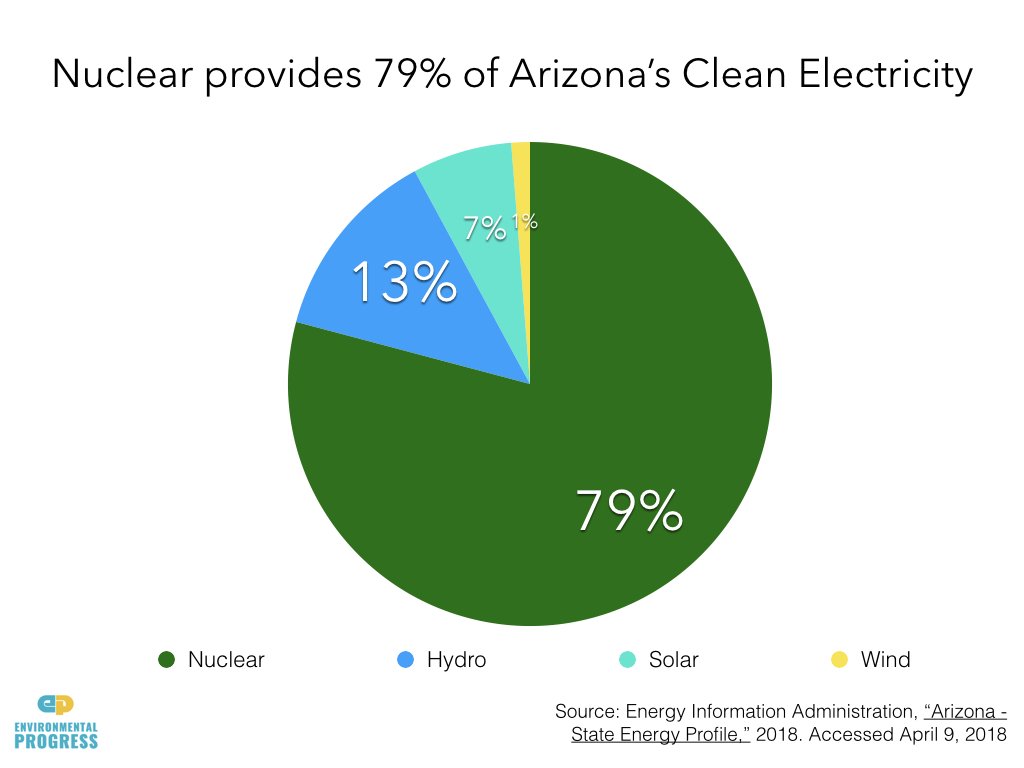Billionaire Energy Speculator Tom Steyer Bankrolls Arizona Initiative That Would Close America's Single Largest Source of Clean Energy
April 10, 2018
By Michael Shellenberger
Tom Steyer, a billionaire energy speculator, is bankrolling an Arizona ballot initiative that would prematurely close the state’s sole nuclear plant — which is also America’s largest single source of clean energy — and replace it with fossil fuels.
If Steyer’s ballot initiative succeeds, Palo Verde will close in 2024 instead of in 2044, according to its operator, Arizona Public Service (APS).
Steyer’s ballot proposal, which will be voted on this November, would require 50 percent of Arizona’s electricity to come from renewable sources like solar and wind — an increase from 13 percent today (over half of which is from hydro-electric dams).
The initiative excludes nuclear from the clean energy mandate even though the Nobel Prize-winning Intergovernmental Panel on Climate Change finds nuclear produces one-quarter of the emissions of solar.
If it passes, the initiative would only increase the share of the state's electricity from clean energy sources by four percent. In 2017, Arizona generated 46 percent of its electricity from clean energy source — 79 percent of which came from Palo Verde.
In order to accommodate such a large increase in intermittent energy from solar and wind, APS would need to close Palo Verde and replace it with natural gas, APS says.
If Palo Verde is replaced entirely by natural gas, carbon emissions in Arizona would increase by the equivalent of adding 2.8 million cars to the road.
Steyer’s wealth derives heavily from his investments in fossil fuels and renewables. A colleague of Steyer’s told The New York Times in 2014 that Steyer’s firm was “like an anchor in the Indonesian coal industry... By drawing money to an overlooked sector, they helped expand the coal industry there.”
Farallon invested heavily in natural gas owning millions in shares of Westport Innovations which makes natural gas engines; Fuel System Solution, and BP, according to investigative reporting done by Lachlan Markay, a reporter for Politico.
Steyer is also a long-time investor in renewables. In 2012, The New York Times reported, “Mr. Steyer, the founder of Farallon Capital Management, is the main financial backer of Greener Capital, a venture firm that invests in renewable energy start-ups.”
If Steyer remains invested in natural gas and/or renewables, he and his charities could benefit financially from the Arizona initiative he is financing.
Steyer acknowledged to The New York Times that he continued to make money from his investments even after stepping down as a manager of his investment firm. "He remains a passive investor," The Times reported Steyer's aides as having said, "though they declined to describe the size of his investment."
“Farallon is still invested in carbon-generating industries," reported the Times, "and [Steyer's] aides declined to say whether Mr. Steyer had asked it to sell those holdings, a request that would presumably hold significant sway given his role as a founder.”
Steyer and his spokespersons declined to comment on the impact of the ballot initiative on Palo Verde or his potential financial conflicts of interest.
“Prematurely retiring Palo Verde in order to satisfy this ill-conceived renewable energy mandate,” Jenna Rowell, an APS spokesperson, told Environmental Progress, “will impose a major setback in our vision of providing a sustainable clean energy future for Arizona.”
APS says it is already planning on retiring its two coal plants. As such, if the Steyer initiative passes, Arizona will become heavily-dependent on natural gas as its only source of reliable electricity.
APS also says the cost of electricity would rise significantly. California and Germany have seen their electricity rates increase by 23% and by 50%, respectively, since they started closing nuclear plants and scaling up renewables.
And yet solar and wind still only comprised 26 percent of Germany’s electricity in 2017 and 23 percent of California’s in 2017 — just half of the 50 percent that Steyer's ballot initiative would require from renewables in 2030.



